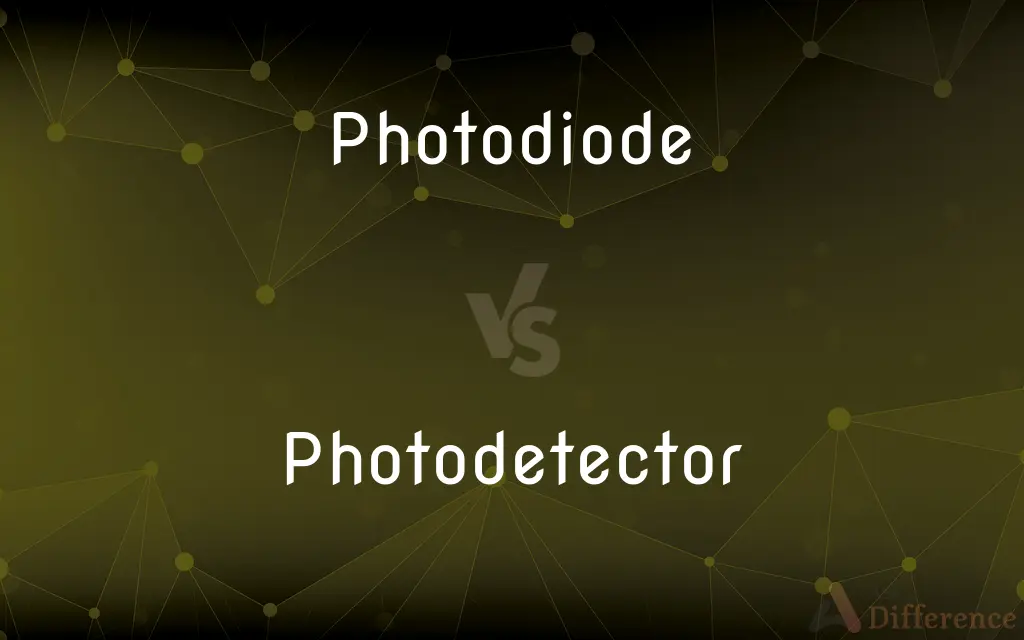Photodiode vs. Photodetector — What's the Difference?
Edited by Tayyaba Rehman — By Fiza Rafique — Updated on March 18, 2024
A photodiode is a semiconductor device that converts light into electrical current, while a photodetector refers to any device that senses light, including photodiodes among others.

Difference Between Photodiode and Photodetector
Table of Contents
ADVERTISEMENT
Key Differences
Photodiodes are specialized semiconductor devices designed to generate an electrical current or voltage when exposed to light, relying on the photoelectric effect. They are known for their speed and sensitivity, particularly in converting light into an electrical signal. On the other hand, photodetectors encompass a broader category of devices that detect light, including photodiodes but also extending to other types like photoresistors, phototransistors, and photomultiplier tubes.
Photodiodes are often used in circuits that require precise light detection and measurement, such as in solar cells, light meters, and optical communication systems. Each type of photodetector has its own unique mechanism and materials for sensing light, and the choice among them depends on the specific requirements of an application, such as sensitivity, spectral response, and speed.
The efficiency of photodiodes in converting light into electrical signals is due to their p-n junction structure, which allows them to operate in reverse bias, enhancing their sensitivity to light. Whereas, photodetectors can operate based on various principles, including thermal effects, quantum effects, and others, offering a range of responses to different light intensities and wavelengths.
Photodiodes are characterized by their fast response time and linearity in response to light intensity, making them suitable for high-speed and high-precision applications. In contrast, the characteristics of photodetectors vary widely depending on their type; for example, phototransistors offer higher sensitivity but slower response times compared to photodiodes.
In practical applications, photodiodes are often used where precise and quick light to electrical signal conversion is needed, such as in fiber optic communication systems. Photodetectors, being a broader category, find use in a wide range of applications, from simple light sensing in everyday electronics to complex scientific instruments requiring highly specialized light detection capabilities.
ADVERTISEMENT
Comparison Chart
Definition
Semiconductor device converting light to electrical current
Any device that senses light
Includes
-
Photodiodes, photoresistors, phototransistors, etc.
Operating Principle
Photoelectric effect in a p-n junction
Various, including thermal, quantum effects
Response Time
Fast
Varies, from fast to slow
Sensitivity
High, especially in reverse bias
Varies widely among types
Applications
Solar cells, optical communications, light meters
Broad, including electronics, scientific instruments, industrial systems
Compare with Definitions
Photodiode
A semiconductor device that converts light into an electrical current through the photoelectric effect.
The photodiode in the solar panel generates current when exposed to sunlight.
Photodetector
Can operate based on different principles suitable for specific applications.
The scientific instrument uses a specialized photodetector for detecting low levels of light.
Photodiode
Used in circuits for precise light detection and measurement.
The light meter's accuracy is ensured by its sensitive photodiode.
Photodetector
Offers a variety of sensitivity and spectral responses.
The camera's photodetector is chosen for its excellent sensitivity across visible wavelengths.
Photodiode
Operates effectively in reverse bias, enhancing sensitivity to light.
The circuit design includes a reverse-biased photodiode for improved light detection efficiency.
Photodetector
Any device capable of sensing light, including a wide range of technologies.
The alarm system's photodetector triggers when the infrared beam is interrupted.
Photodiode
Characterized by fast response times and linearity with light intensity.
The photodiode's quick response is crucial in high-speed optical communication.
Photodetector
Includes devices with varying response times, from fast to slow.
The smoke detector's photodetector has a slow response, adequate for its application.
Photodiode
Commonly found in devices requiring accurate and quick light sensing.
Photodiodes are essential components in fiber optic receivers.
Photodetector
Used in diverse applications, from simple to complex systems.
Photodetectors in automatic doors sense the presence of people through changes in light.
Photodiode
A photodiode is a semiconductor p-n junction device that converts light into an electrical current. The current is generated when photons are absorbed in the photodiode.
Photodetector
Photodetectors, also called photosensors, are sensors of light or other electromagnetic radiation. There is a wide variety of photodetectors which may be classified by mechanism of detection, such as photoelectric or photochemical effects, or by various performance metrics, such as spectral response.
Photodiode
A diode that exhibits sensitivity to light, either by varying its electrical resistance like a photoresistor or by generating a electric potential in the manner of a photoelectric cell.
Photodetector
Any device used to detect electromagnetic radiation
Photodiode
(electronics) A semiconductor two-terminal component whose electrical characteristics are light-sensitive.
Common Curiosities
What is the main application of photodiodes?
Photodiodes are widely used in applications requiring precise and rapid conversion of light into electrical signals, such as in optical communication systems, light meters, and solar cells.
What makes a photodiode different from other photodetectors?
A photodiode is specifically a semiconductor device that uses the photoelectric effect to convert light into electrical current, characterized by its speed and sensitivity, whereas photodetectors include a broader range of devices with various sensing mechanisms.
Are photodiodes used in consumer electronics?
Yes, photodiodes are found in many consumer electronics, such as digital cameras, where they are used for light detection and image capture.
What factors influence the choice of a photodetector for a specific application?
Factors include sensitivity to the desired wavelength of light, response time, noise characteristics, and the specific requirements of the application, such as the need for high-speed detection or the ability to detect low levels of light.
Can a photodetector be used for measuring light intensity?
Yes, many photodetectors, including photodiodes, are used to measure light intensity, with their response to light being quantifiable and often linear, making them suitable for such measurements.
Can photodiodes detect all types of light?
Photodiodes are sensitive to a range of light, but their sensitivity spectrum depends on the semiconductor material used. Some are optimized for visible light, while others are designed for infrared or ultraviolet light.
Are all photodetectors made of semiconductor materials?
Many photodetectors, including photodiodes, are made of semiconductor materials, but not all. For example, photomultiplier tubes, another type of photodetector, operate based on the photoemissive effect and are not semiconductor-based.
How do photodiodes convert light into electrical signals?
Photodiodes convert light into electrical signals through the photoelectric effect, where photons of light generate electron-hole pairs in the semiconductor material, creating a flow of electrical current.
How do environmental conditions affect photodiodes?
Environmental conditions like temperature can affect the performance of photodiodes, potentially altering their sensitivity and response time. Many photodiodes are designed to be stable across a range of temperatures.
Can photodiodes be used for energy generation?
Photodiodes are used in solar cells, a type of photodiode specifically designed for energy generation by converting sunlight into electrical energy.
Share Your Discovery

Previous Comparison
Chlorite vs. Chlorate
Next Comparison
Sixth vs. SixAuthor Spotlight
Written by
Fiza RafiqueFiza Rafique is a skilled content writer at AskDifference.com, where she meticulously refines and enhances written pieces. Drawing from her vast editorial expertise, Fiza ensures clarity, accuracy, and precision in every article. Passionate about language, she continually seeks to elevate the quality of content for readers worldwide.
Edited by
Tayyaba RehmanTayyaba Rehman is a distinguished writer, currently serving as a primary contributor to askdifference.com. As a researcher in semantics and etymology, Tayyaba's passion for the complexity of languages and their distinctions has found a perfect home on the platform. Tayyaba delves into the intricacies of language, distinguishing between commonly confused words and phrases, thereby providing clarity for readers worldwide.














































